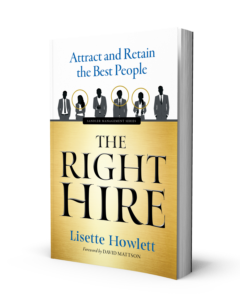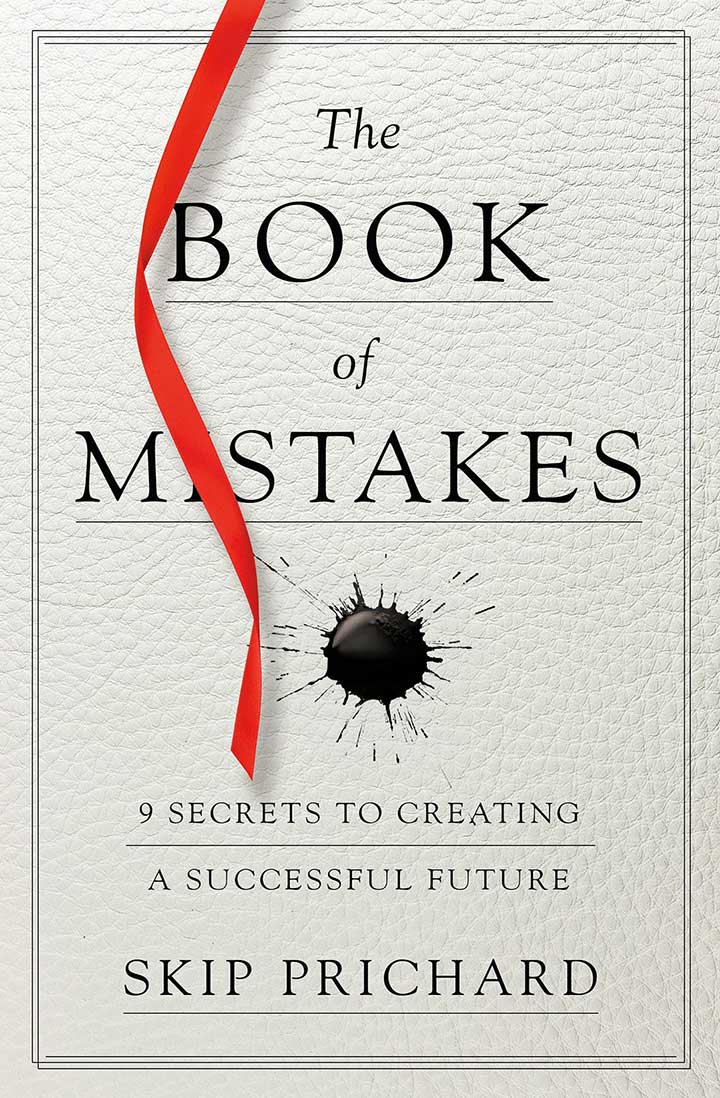Hire the Best
During one of my interviews, someone asked me about my biggest career mistakes.
“That’s easy,” I said, “I have made the mistake of hiring the wrong person. It is an expensive error.”
Since that early career mistake, I have developed a number of strategies and techniques to reduce my hiring errors. And that’s why I loved The Right Hire: Attract and Retain the Best People because the book shares many techniques to get the right person for the job. The book explains that hiring should be both part of the organizational strategy and strategic. I had the opportunity to speak with Lisette Howlett who has fifteen years of global change leadership and business development experience.
Make Hiring Right A Part of Your Strategy
How do leaders ensure that hiring is part of the overall organizational strategy?
At its most simplistic, by simply putting it into the strategic plan and elevating it to be part of the leadership and strategic agenda.
The strategic plan outlines where the organization aims to be in the chosen timeframe, typically 5 years, and it should include a section on the organization implications and the hiring strategy required for success. Adopting an effective hiring strategy is core to the achievement of this plan and will cover different aspects depending on the organization’s strategic intent. If, for example, the organization is seeking to change direction, expand to new markets or even leave markets and sectors, the hiring plan needs to reflect this. How will people be hired in anticipation of the future plans, how will they be developed and made ready? Hiring in this context is not just hiring new talent into the organization from outside but also hiring (or promoting) people from within the organization to new roles and locations. And similarly, if an organization is exiting a market or geography, thinking about how any key talent in this unit might be retained is critical as well and should be part of the exit plan.
In terms of elevating hiring to be an integral part of the leadership and strategic agenda, one of the best ways to do this is to adopt a balanced scorecard approach and ensure that time is spent on broader leadership topics as well as financial performance.
The less simple way is to invest in the development of what I have called a hiring culture. This is a culture where the organization is always on the lookout for talent and takes action when it is spotted. The search for talent, once again, can be internal as well as external.
Additionally, taking a more strategic approach to hiring will go a long way towards ensuring that hiring is part of the organizational strategy. By this I mean that we need to move away from treating it as a transaction that is forced upon managers due to the need of someone to fill a vacant position in the organization. We need to think of hiring in the medium term and even long term and start to develop hiring plans to support this. At the organizational level, think of the competencies and attitudes that you will need for ongoing organizational success and start hiring for them now. Plan the numbers and skills you will need for your future organization and work to that plan. For jobs that you know you will always be recruiting, invest in strong talent sourcing systems and hire continually whenever you spot talent. Hiring ahead of the curve will give you the time to wait for top talent rather than rush to bring someone in just to cover the mounting workload.
The Cost of a Wrong Hire
I’m always surprised at the high cost of a wrong hire. Would you share some of the statistics on making a bad choice?
I agree, few people really think about the true cost of a wrong hire. Not only do they underestimate the cost of a poor hire, which I will outline here, but potentially even more importantly they define wrong hire very narrowly and thus miss out on considerable additional costs.
Taking the last point first, generally when considering wrong hires, leaders count only those hires which have led to the requirement to dismiss the employee. I would suggest, however, that they should consider also the cost of hiring people who do not perform sufficiently badly to lead to an early exit but are simply mediocre in that specific role, or when operating in your particular company environment. These are the people who tend to stay with the organization with neither party (employee and manager) satisfied but equally neither so dissatisfied that they take action. The cost here should be measured not only in the loss of performance (productivity) but also the impact on the motivation of the rest of the team.
Turning to the true cost of a wrong hire, “Industry estimates put the cost of a bad hire at somewhere between 1 and 2.5 times the person’s annual salary. For salespeople, the true cost is, in fact, considerably higher when you build in opportunity costs. Our estimate, based on experience, is that this falls somewhere between 10 and 25 times the annual salary.” (Howlett, The Right Hire, page 8.)
The following are the main costs that should be estimated when benchmarking your cost of hiring failure:
- The costs of hiring the person. It is good practice to track this as a standard practice. I recommend looking at variable costs only (ignoring the fixed costs, staff, hiring portal etc. that would be in place regardless of this particular hire). Variable costs include search or recruitment fees paid to an external agency (not all will be refundable); costs of assessments, reference checking etc.; travel and related costs for candidates and recruiting team; relocation costs; HR and hiring manager/team time and admin costs.
- Direct compensation costs. This is their remuneration, bonus, benefits.
- Cost of employing the person. Onboarding, training, management time, overheads
- Cost of exiting the person. Severance payments, outplacement, losses (loss of clients, reputational damage, legal claims), administrative costs and time on the exit process
- Opportunity costs. The costs of missed or wasted business opportunities. These are highest for senior executives and sales people.
- Impact or disruption costs. This includes both the impact of the individual on your organization and its stakeholders including customers and the impact on other employees of this bad hire.
How can hiring managers best use the acronym SEARCH?
The acronym SEARCH will help you identify and organize the attributes you require for job success and help you with the ongoing management of your people.
- Skills: What specific skills must successful candidates possess?
- Experience: What specific activities, types of clients, areas of responsibility, work history, and background factors are relevant to the job under consideration?
- Attitudes: How do the candidates approach work, colleagues, and life? What guiding principles should successful candidates possess?
- Results: What success have candidates had in the past? What results have been produced in similar situations? Have these individuals outperformed others in a similar situation?
- Cognitive skills: What is their ability to learn the information and processes necessary to do the job well? What is the candidate’s ability to think and learn relative to the demands of the job?
- Habits: What specific behaviors and approaches to accomplishing life tasks and getting work done are necessary for the successful candidates in this position?
SEARCH should be used as part of the templating step of the hiring process. “Creating standard templates for everything you do is an important part of effective recruitment. You want to deploy your thinking and creativity while with the candidate and in the selection decision. The more effective and efficient the hiring process you follow, the more time and attention you can give to the other aspects of recruiting and hiring.”
Creating a SEARCH profile for each role, in advance of hiring, allows you not just to hire and select successfully for the role but also to undertake a number of additional important management activities.
SEARCH also profiles a template for onboarding your new employees, allows you to talk to them about the skills, results and habits that you would expect to see and develop in the role.
It supports performance management, allowing the manager to do a gap analysis on the individual and coach them towards higher performance. Here you might focus on skills, results, habits and also attitude.
Equally it can provide a base for development planning and training investment using, in particular, the skills, experience and cognitive skills elements.
Use Attitude, Technique, and Behavior
You also use The Success Triangle and the three core elements of Attitude, Technique, and Behavior. It seems that many managers know these elements but don’t systematically put them into use. Is that true? How do you recommend using it?
Just in case The Success Triangle is not fully known, the three elements are
Attitude – outlook and expectations; confidence and conviction
Technique – strategies and tactics; knowing the right thing to do and say in a given situation
Behavior – actually doing the right things in a consistent basis (“muscle memory”)
In the context of hiring I recommend using the Success Triangle at two levels. First, in terms of what you will be looking for in your candidates. Second, in terms of the recruiters themselves, and by implication the organization.
Looking at this in more detail:
Recruitment behavior is related to having a systematic approach to the process. Keep the employee value proposition in the forefront of everything that you do and take full advantage of opportunities to increase the talent within your organization. In terms of recruitment, attitude communicates itself to potential candidates in everything you do. Recruiting managers with a strong positive attitude find it easier to bring in top talent. People want to join teams where the people have a positive attitude towards themselves, each other, the company and its products or services. And finally, Technique which is related to skills, which means the skills to screen candidates, conduct effective interviews and spot talent.
What are some of the interviewing skills that every manager must develop?
Being able to conduct an effective interview is a basic skill requirement. Indeed, feedback suggests that a candidate who has a good interview experience, even if they do not obtain the role, may still talk favorably about the company.
Listening and not talking. The ability to be laser focused on what the candidate is saying is important. Too often people talk as a way of showing interest or empathy. For example, the candidate says, “X is very important to me,” and the interviewer jumps in with, “Yes that’s important to me too, in fact it is why I decided to join the company and what keeps me motivated.” As this example illustrates, it is at best evidence that you are more interested in yourself that the other person and in this particular case. At worst, it looks like false over-selling.
Questioning. Being able to ask high quality questions that dig deep into what the other person is saying without looking like it’s an interrogation is a really important skill when interviewing. It is also helpful in many other areas as well – management, customer services, sales, and so on.
Being able to analyze and draw valid judgements from the information collected through listening is another critical skill. Listening and not talking is not enough; you also need to hear the information, analyze it and make sound selection judgements based on it. Judgements that are not clouded by preconceptions.
I talk a lot about the art and science of hiring. Some of these skills need to be honed through practice and self-reflection and learning. They can also be developed in other aspects of a manager’s role and used in recruitment.
Finally, I would like to add that I do not believe that a manager should be allowed to hire until they have both been trained and also ‘certified’—passed as fit to interview and hire. This sounds a bit draconian, but unless a performance standard is in place, too many managers will hire without the necessary competence and end up making poor decisions—decisions that will have a long-term impact on the organization
Use the Best Onboarding Practices
Onboarding is a crucial component. What are some of the best onboarding practices you have seen?
Onboarding is indeed a crucial component, and one of the most ignored aspects of the hiring process: all that time and effort spent finding the right hire and then you just sit back and hope they make it.
One of the best onboarding practices I have seen, from a structure and process point of view, is having the program fully templated and developed well before the hiring starts. A good onboarding program includes a minute-by-minute breakdown of the first day and a detailed breakdown of the first 10 days and then weekly learning/performance targets for the first 3 months (or more should the job require it). One of the problems with starting a new role is that everyone but you is busy, and if you’re not careful, you can find yourself sitting around not know what to do. Clearly new hires need a bit of time to relax and reflect on all the information they are being given, but this should be well organized. So, if you want them to read material, include a purpose or task – such as, “Review xx product or client and pull together a summary of key information.” Not only does this give them a reason for their research but also allows you to check their understanding and their ability to identify and summarize key information. Also, while it might be that they cannot do some aspects of their role until they know more, get them doing something that approximates this as early as possible. To illustrate this, if phoning customers is part of their role but they cannot phone them until they know more about the products, get them to phone them for a different reason, perhaps to check the information you hold on them or to invite them to an event or something—just so that they are on the phones starting day 1.
One of my favorite examples of best practice is where the onboarding program is left to the individual to execute. Here I do not mean they are given a binder as they walk in the door and told to ‘get to it’ but that they are given the explanation and support to be self-managing. It sets up really good behaviors around taking responsibility, taking action, resource investigation and problem solving. This example included daily check-ins for the first 10 days and then weekly check-ins for the first 3 months with the individual where they were asked to report back on progress and to share where they felt the need for additional support or help. These check-ins were focused solely on the onboarding process and not diluted with topics covered in normal manager-team member one-on-ones.
For more information, see The Right Hire: Attract and Retain the Best People .


